+ Open data
Open data
- Basic information
Basic information
| Entry | Database: PDB / ID: 6cdg | ||||||
|---|---|---|---|---|---|---|---|
| Title | GID4 fragment in complex with a peptide | ||||||
 Components Components |
| ||||||
 Keywords Keywords | PEPTIDE BINDING PROTEIN / structural genomics consortium / SGC | ||||||
| Function / homology | Vacuolar import/degradation protein Vid24 / Vacuolar import and degradation protein / ubiquitin ligase complex / Regulation of pyruvate metabolism / ubiquitin protein ligase activity / proteasome-mediated ubiquitin-dependent protein catabolic process / cytosol / Glucose-induced degradation protein 4 homolog Function and homology information Function and homology information | ||||||
| Biological species |  Homo sapiens (human) Homo sapiens (human)synthetic construct (others) | ||||||
| Method |  X-RAY DIFFRACTION / X-RAY DIFFRACTION /  FOURIER SYNTHESIS / Resolution: 1.6 Å FOURIER SYNTHESIS / Resolution: 1.6 Å | ||||||
 Authors Authors | Dong, C. / Tempel, W. / Bountra, C. / Arrowsmith, C.H. / Edwards, A.M. / Min, J. / Structural Genomics Consortium (SGC) | ||||||
 Citation Citation |  Journal: Nat. Chem. Biol. / Year: 2018 Journal: Nat. Chem. Biol. / Year: 2018Title: Molecular basis of GID4-mediated recognition of degrons for the Pro/N-end rule pathway. Authors: Dong, C. / Zhang, H. / Li, L. / Tempel, W. / Loppnau, P. / Min, J. | ||||||
| History |
|
- Structure visualization
Structure visualization
| Structure viewer | Molecule:  Molmil Molmil Jmol/JSmol Jmol/JSmol |
|---|
- Downloads & links
Downloads & links
- Download
Download
| PDBx/mmCIF format |  6cdg.cif.gz 6cdg.cif.gz | 51 KB | Display |  PDBx/mmCIF format PDBx/mmCIF format |
|---|---|---|---|---|
| PDB format |  pdb6cdg.ent.gz pdb6cdg.ent.gz | 34.3 KB | Display |  PDB format PDB format |
| PDBx/mmJSON format |  6cdg.json.gz 6cdg.json.gz | Tree view |  PDBx/mmJSON format PDBx/mmJSON format | |
| Others |  Other downloads Other downloads |
-Validation report
| Summary document |  6cdg_validation.pdf.gz 6cdg_validation.pdf.gz | 420.5 KB | Display |  wwPDB validaton report wwPDB validaton report |
|---|---|---|---|---|
| Full document |  6cdg_full_validation.pdf.gz 6cdg_full_validation.pdf.gz | 420.5 KB | Display | |
| Data in XML |  6cdg_validation.xml.gz 6cdg_validation.xml.gz | 9 KB | Display | |
| Data in CIF |  6cdg_validation.cif.gz 6cdg_validation.cif.gz | 11.9 KB | Display | |
| Arichive directory |  https://data.pdbj.org/pub/pdb/validation_reports/cd/6cdg https://data.pdbj.org/pub/pdb/validation_reports/cd/6cdg ftp://data.pdbj.org/pub/pdb/validation_reports/cd/6cdg ftp://data.pdbj.org/pub/pdb/validation_reports/cd/6cdg | HTTPS FTP |
-Related structure data
| Related structure data | 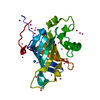 6ccrC  6cctC 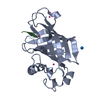 6ccuC 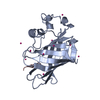 6cd8C 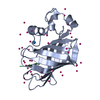 6cd9C 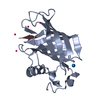 6cdcC C: citing same article ( |
|---|---|
| Similar structure data |
- Links
Links
- Assembly
Assembly
| Deposited unit | 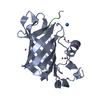
| ||||||||
|---|---|---|---|---|---|---|---|---|---|
| 1 |
| ||||||||
| Unit cell |
|
- Components
Components
| #1: Protein | Mass: 19604.777 Da / Num. of mol.: 1 / Fragment: residues 124-289 Source method: isolated from a genetically manipulated source Source: (gene. exp.)  Homo sapiens (human) / Gene: GID4, C17orf39, VID24 / Plasmid: pET28-MHL / Production host: Homo sapiens (human) / Gene: GID4, C17orf39, VID24 / Plasmid: pET28-MHL / Production host:  | ||
|---|---|---|---|
| #2: Protein/peptide | Mass: 687.807 Da / Num. of mol.: 1 / Source method: obtained synthetically / Source: (synth.) synthetic construct (others) | ||
| #3: Chemical | ChemComp-UNX / #4: Water | ChemComp-HOH / | |
-Experimental details
-Experiment
| Experiment | Method:  X-RAY DIFFRACTION / Number of used crystals: 1 X-RAY DIFFRACTION / Number of used crystals: 1 |
|---|
- Sample preparation
Sample preparation
| Crystal | Density Matthews: 2.08 Å3/Da / Density % sol: 40.84 % / Mosaicity: 0.19 ° |
|---|---|
| Crystal grow | Temperature: 291 K / Method: vapor diffusion, sitting drop / Details: 20% PEG3350, 0.2M sodium bromide |
-Data collection
| Diffraction | Mean temperature: 100 K | |||||||||||||||||||||||||||||||||
|---|---|---|---|---|---|---|---|---|---|---|---|---|---|---|---|---|---|---|---|---|---|---|---|---|---|---|---|---|---|---|---|---|---|---|
| Diffraction source | Source:  ROTATING ANODE / Type: RIGAKU FR-E SUPERBRIGHT / Wavelength: 1.5418 Å ROTATING ANODE / Type: RIGAKU FR-E SUPERBRIGHT / Wavelength: 1.5418 Å | |||||||||||||||||||||||||||||||||
| Detector | Type: RIGAKU SATURN A200 / Detector: CCD / Date: Oct 24, 2017 | |||||||||||||||||||||||||||||||||
| Radiation | Protocol: SINGLE WAVELENGTH / Monochromatic (M) / Laue (L): M / Scattering type: x-ray | |||||||||||||||||||||||||||||||||
| Radiation wavelength | Wavelength: 1.5418 Å / Relative weight: 1 | |||||||||||||||||||||||||||||||||
| Reflection | Resolution: 1.6→40.65 Å / Num. obs: 21138 / % possible obs: 95.4 % / Redundancy: 3.7 % / CC1/2: 0.999 / Rmerge(I) obs: 0.076 / Rpim(I) all: 0.046 / Rrim(I) all: 0.089 / Net I/σ(I): 13.1 / Num. measured all: 77760 / Scaling rejects: 0 | |||||||||||||||||||||||||||||||||
| Reflection shell | Diffraction-ID: 1
|
- Processing
Processing
| Software |
| |||||||||||||||||||||||||||||||||||||||||||||||||||||||||||||||||||||||||||
|---|---|---|---|---|---|---|---|---|---|---|---|---|---|---|---|---|---|---|---|---|---|---|---|---|---|---|---|---|---|---|---|---|---|---|---|---|---|---|---|---|---|---|---|---|---|---|---|---|---|---|---|---|---|---|---|---|---|---|---|---|---|---|---|---|---|---|---|---|---|---|---|---|---|---|---|---|
| Refinement | Method to determine structure:  FOURIER SYNTHESIS FOURIER SYNTHESISStarting model: an unpublished, nearly isomorphous crystal structure of GID4 Resolution: 1.6→32.9 Å / Cor.coef. Fo:Fc: 0.954 / Cor.coef. Fo:Fc free: 0.933 / SU B: 3.275 / SU ML: 0.105 / Cross valid method: THROUGHOUT / σ(F): 0 / ESU R: 0.111 / ESU R Free: 0.111 Details: The starting model from a nearly isomorphous starting model could be refined without molecular replacement search.
| |||||||||||||||||||||||||||||||||||||||||||||||||||||||||||||||||||||||||||
| Solvent computation | Ion probe radii: 0.8 Å / Shrinkage radii: 0.8 Å / VDW probe radii: 1.2 Å | |||||||||||||||||||||||||||||||||||||||||||||||||||||||||||||||||||||||||||
| Displacement parameters | Biso max: 55.69 Å2 / Biso mean: 21.326 Å2 / Biso min: 9.44 Å2
| |||||||||||||||||||||||||||||||||||||||||||||||||||||||||||||||||||||||||||
| Refinement step | Cycle: final / Resolution: 1.6→32.9 Å
| |||||||||||||||||||||||||||||||||||||||||||||||||||||||||||||||||||||||||||
| Refine LS restraints |
| |||||||||||||||||||||||||||||||||||||||||||||||||||||||||||||||||||||||||||
| LS refinement shell | Resolution: 1.602→1.644 Å / Total num. of bins used: 20
|
 Movie
Movie Controller
Controller




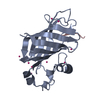
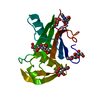


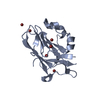
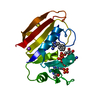
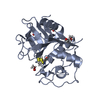
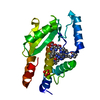
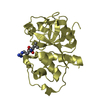
 PDBj
PDBj


